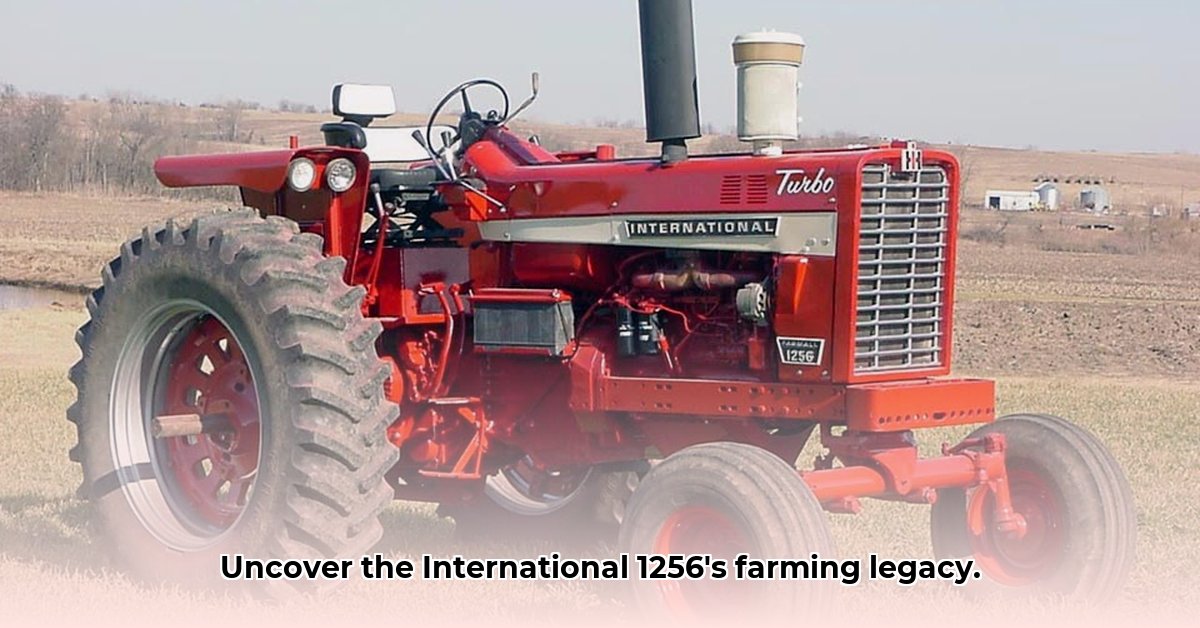
The International 1256 tractor, a stalwart of the late 1960s and early 1970s, holds a unique position in agricultural history. More than just a machine, it represents a significant step in agricultural technology, impacting farming efficiency in ways still felt today. This article explores the 1256's design, performance, and surprisingly relevant connection to modern sustainable farming practices. For more information on International Harvester tractors, check out this useful resource.
A Closer Look: The Design and Specifications of the International 1256
The International 1256 was, in its time, a powerful machine. Its 6.7-liter six-cylinder diesel engine delivered approximately 100-115 horsepower, a substantial output for the era. This power, combined with available standard and row-crop configurations, made it remarkably versatile. Farmers could adapt the 1256 to their specific needs and field conditions. But what were the specifics of this technological marvel?
The tractor's hydraulic system, while simpler than modern systems, was reliable and effective. It utilized an open-center design, meaning oil flow was directed only when needed by a hydraulic implement. This simplicity, while lacking the precision of modern closed-center systems, contributed to the 1256's dependability. Similarly, its single-valve control, though less sophisticated than multi-function levers found in contemporary tractors, provided straightforward operation. The simplicity of the design also contributed to its ease of maintenance.
Here's a summary of its key specifications:
| Feature | Specification | Notes |
|---|---|---|
| Engine | 6.7L six-cylinder diesel | A powerful engine for its era, providing substantial torque. |
| Horsepower | Approximately 100-115 hp | Varied slightly depending on configuration and measurement methods. |
| Hydraulic System | Open-center | A simpler, yet effective system compared to modern closed-center counterparts. |
| PTO System | Standard | Provided power to various implements, enhancing versatility. |
| Configurations | Standard and row-crop | Designed to suit diverse farming styles and field conditions. |
This wasn't just an assembly of parts; it was a robust machine built to endure the rigors of farm work, representing a significant advancement in agricultural engineering for its time. Isn't it fascinating how much technology has changed in just a few decades?
Performance and Environmental Considerations: A Historical Perspective
Quantifying the 1256's field performance is challenging due to limited readily available data on fuel consumption. This scarcity makes direct comparison to modern tractors difficult. However, it's generally understood that fuel efficiency wasn't a primary design focus during this era. Robustness and power were paramount. Therefore, its fuel consumption should be understood within its historical context, not judged by today's stringent efficiency standards. Heavier soils would have likely demanded careful management to avoid compaction.
This lack of precise data underscores the need for further research to fully understand the 1256's environmental impact. A comprehensive life-cycle assessment (LCA), encompassing manufacturing, operation, and eventual disposal, would provide valuable insights. This would allow for a more accurate comparison with modern, more fuel-efficient tractors.
The Enduring Legacy and Modern Relevance of the 1256
The International 1256 remains relevant today, despite its vintage status. Collectors cherish its rugged build and historical significance. Moreover, agricultural historians study the 1256 to understand the technological advancements of its time. Its sturdy construction offers a compelling example of durable engineering, which raises an important question: Can modern sustainable agriculture learn from this robust design to manufacture more resilient and long-lasting machinery? This is an area worthy of further examination.
Conclusion: A Case Study in Agricultural Evolution
The International 1256 tractor provides a rich case study, showcasing a significant milestone in agricultural technology. It highlights the remarkable progress in farming mechanization while underscoring the ever-evolving pursuit of sustainable farming practices. By analyzing its strengths and weaknesses, we gain invaluable insight into the evolution of agricultural machinery and the ongoing quest for increased efficiency and environmental responsibility. The 1256's legacy serves as a reminder of the continuous journey towards a more sustainable future for agriculture. The tractor's story prompts further exploration into the development and integration of environmentally responsible practices into the design and manufacture of modern farm equipment.